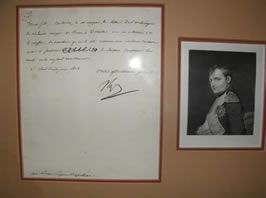Napoleon Letter (posted 2/6/11)

The National Cryptologic Museum Library has on display an autographed letter of Napoleon Bonaparte ordering the continued interception of foreign letters. Written to his adopted son, Eugene de Beauharnais, whom he had made viceroy of the kingdom of Naples, it is pictured here, and the English translation follows:
“St. Cloud. 24 June 1806. My son: Continue to send me the letters of the archbishop of Silesia, sent from Rome to Dresden; they have found the cipher here, so that we can read them like ordinary writing; but it is necessary to let them go on their way while copying them exactly. Nap.”
Napoleon was then at the height of his power. He had crowned himself emperor of the French, had just won just his great victory at Austerlitz over the Austrian and Russian armies, and had forced Prussia to accept a humiliating treaty. He was master of Europe. The defeat of his fleet by Nelson at Trafalgar prevented him from invading Britain. So early in 1806, he turned east and in the path of that stride lay Silesia. This area -- never a separate country –lies in what is today southwest Poland. Its largest city was Breslau (Wroclaw, in Polish) and its archbishop – the target of Napoleon’s interception -- was Prince Joseph Christian von Hohenlohe-Bartenstein, member of an ancient German family. Apparently assigned to or visiting the Vatican, had been communicating with people in Dresden, the beautiful capital of the kingdom of Saxony, Silesia’s neighbor to the west. It was the prince’s letters that Napoleon wanted to open, copy, and forward while secretly solving, reading, and exploiting them.
A decade earlier, Napoleon had conquered Italy and named himself king. By then he had married Josephine de Beauharnais and adopted her son, Eugene. Eugene had proved himself brave in combat and able in administration, and in 1805 Napoleon named him viceroy of Italy. He was therefore in a position to control the mail.
On the 24 June that he issued his instructions to Eugene, Napoleon was in his residence at St. Cloud, on the Seine west of Paris. Like most authoritarian rulers, he had a letter-opening office – that being the wiretapping of the day. His lay in Coq Héron street; probably it used current techniques: thin heated knives to lift the wax seals off the paper, slender flexible rods with a slot to furl letters around and extract them without having to open the envelope, cryptanalysts to solve the enciphered portions Napoleon received the intercepts every morning in a small red moroccan envelope marked “Foreign newspapers.” After reading them, and perhaps making decisions based on their information, he burned them.
The letter to his stepson was not the only instruction about mail that he issued. He ordered him on 27 January 1806 to intercept the mail of the queen of Naples, and Eugene said he set up a bureau to intercept all English mail. None of these sources say what information these sources provided or how Napoleon used it. It probably did not much help Napoleon to win the battle of Jena in October 1806, and could not have hurt in arranging the alliance two months later between France and Saxony.
How did a Napoleon document get to the National Cryptologic Museum? It is recorded in 1863 as being in the archive of the duchess of Leuchtenberg, an heir of Eugene, who had been awarded the dukedom (Correspondance de Napoléon Ier [Paris: Imprimerie impérial, 1862], vol. 12, p. 594, No. 10408 [in which Silésie is incorrectly given as Séléucie, a city of ancient Babylon]. The document next surfaced in the now defunct New York department store, B. Altman. No documents say how it reached private hands for sale to B. Altman, but probably someone with access to that repository stole it and sold it for its value as a Napoleon signature. The store sold it to David Kahn, with a letter attesting to its legitimacy. Kahn donated it to the National Cryptologic Museum Library. It remains displayed there as a dramatic example of how one of the greatest generals of all time valued communications intelligence. (Background info provided by David Kahn)


